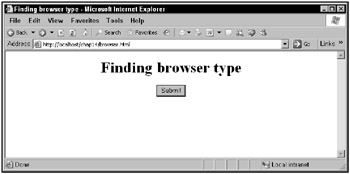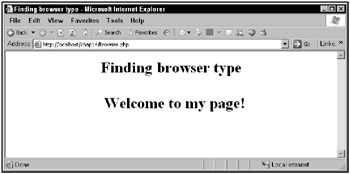Looking at Server Variables
PHP has a special array built in called $_SERVER, which contains a lot of useful information, such as $_SERVER['PHP_SELF'], which holds the name of the current script, and $_SERVER['REQUEST_METHOD'], which holds the request method that was used (GET, POST, and so on).
The most useful server variables available in $_SERVER are listed in Table 14.1.
| Server Variable | Description |
|---|---|
| AUTH_TYPE | When operating under Apache and using authenticated HTTP this variable holds the authentication type. |
| DOCUMENT_ROOT | Contains the document root directory under which the script is executing. |
| GATEWAY_INTERFACE | Contains the revision of the CGI specification the server is using. |
| HTTP_ACCEPT | Contains the text in the Accept: header from the current request. |
| HTTP_ACCEPT_CHARSET | Contains the text in the Accept-Charset: header from the current request. |
| HTTP_ACCEPT_ENCODING | Contains the text in the Accept-Encoding: header from the current request. |
| HTTP_ACCEPT_LANGUAGE | Contains the text in the Accept-Language: header from the current request. |
| HTTP_CONNECTION | Contains the text in the Connection: header from the current request. |
| HTTP_HOST | Contains the text in the Host: header from the current request. |
| HTTP_REFERER | Contains the address of the page (if any) that referred the user agent to the current page. Set by the browser. |
| HTTP_USER_AGENT | Contains the text in the User-Agent: header from the current request. |
| PATH_TRANSLATED | Specifies the file system-based path to the script. |
| PHP_AUTH_PW | When running under Apache using HTTP authentication, this variable holds the password the user provides. |
| PHP_AUTH_USER | When running under Apache using HTTP authentication, this variable holds the username the user provides. |
| PHP_SELF | Contains the filename of the currently executing script, relative to the document root. |
| QUERY_STRING | Contains the query string, if there was any. |
| REMOTE_ADDR | Contains the IP address from which the user is viewing the current page. |
| REMOTE_HOST | Contains the Host name from which the user is viewing the current page. |
| REMOTE_PORT | Contains the port being used on the user’s machine to communicate with the Web server. |
| REQUEST_METHOD | Specifies which request method was used to access the page; such as GET, HEAD, POST, PUT. |
| REQUEST_URI | The URL that was given in order to access this page, such as /index.html. |
| SCRIPT_FILENAME | The absolute pathname of the currently executing script. |
| SCRIPT_NAME | Contains the current script’s path. This is useful for pages that need to point to themselves. |
| SERVER_ADMIN | Contains the value given to the SERVER_ADMIN directive in the Web server configuration file. |
| SERVER_NAME | Contains the name of the server host under which the script is executing. |
| SERVER_PORT | Contains the port on the server machine being used by the Web server for communication. |
| SERVER_PROTOCOL | Contains the name and revision of the information protocol by which the page was requested. |
| SERVER_SIGNATURE | Contains the server version and virtual host name. |
| SERVER_SOFTWARE | Contains the server identification string. |
Say you wanted to determine the type of browser the user has; you might want to use a <marquee> element, for example, which is supported only by Microsoft Internet Explorer. You could start with this page, browser.html:
<html> <head> <title> Finding browser type </title> </head> <body> <center> <h1>Finding browser type</h1> <form method="post" action="browser.php"> <input type="submit" value="Submit"> </form> </center> </body> </html>
In browser.php, you can check whether you’re dealing with Internet Explorer by using the PHP strpos function to search $_SERVER["HTTP_USER_AGENT"] for the text MSIE, which that string contains if you’re using Internet Explorer:
<html> <head> <title>Finding browser type</title> </head> <body> <center> <h1>Finding browser type</h1> <br> <? if(strpos($_SERVER["HTTP_USER_AGENT"], "MSIE")){ . . . } ?> </center> </body> </html> If you are using Internet Explorer, you can display a <marquee> element; otherwise, you might just display a message:
<html> <head> <title>Finding browser type</title> </head> <body> <center> <h1>Finding browser type</h1> <br> <? if(strpos($_SERVER["HTTP_USER_AGENT"], "MSIE")){ echo("<marquee><h1>Welcome to my page!</h1></marquee>"); } else { echo("<h1>Please get Internet Explorer</h1>"); } ?> </center> </body> </html> The browser.html page is shown in Figure 14.3.

Figure 14.3: The browser.html page
When you click the Submit button, you see the marquee if you’re using Internet Explorer, as shown in Figure 14.4.

Figure 14.4: The browser.php application
You can also group the data from a form into an array for easier handling in PHP, which is discussed in the next section.